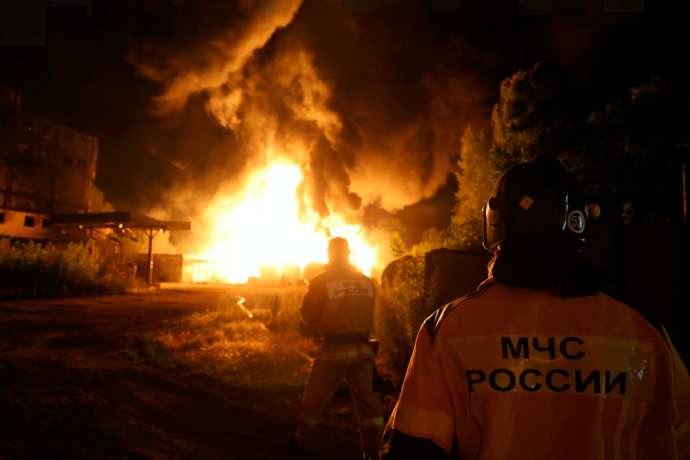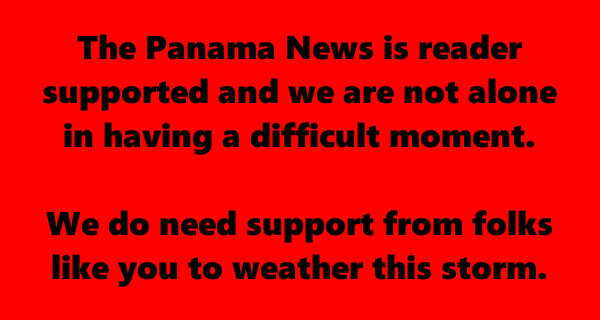Fuel tanks burn after a shelling Russian officials said was conducted by Ukrainian forces at a fuel depot in Makiivka in Russian-controlled Donetsk region on July 5, 2023. AP photo by Alexei Alexandrov.
There are civilian casualties on both sides
of the front lines in the war in Ukraine
by Alexander Hill, University of Calgary
Western news sources regularly report on civilian deaths on the Ukrainian side of the front lines of the war in Ukraine. But what about civilian deaths on the Russian side?
In May 2023, the United Nations reported 8,791 civilians have died and 14,815 have been injured in Ukraine since February 2022. Of those, 1,971 have been killed and 2,636 injured on territory occupied by the Russian Federation.
Western news outlets have tended to only provide details on a regular basis of those casualties suffered on the Ukrainian side of the front line. Exceptions to this — when the western media has widely reported on casualties behind Russian lines — have largely been when Russian forces have been accused of atrocities.
As Ukraine began an offensive against Russian forces in the fall of 2022, instances of civilian deaths resulting from Ukrainian missiles, rockets, drones, artillery and small arms fire on Russian-held territory inevitably increased.
Just as western news sources regularly report on deaths from missile, drone and artillery attacks on Ukrainian-held territory, Russian news outlets frequently report deaths and injuries on Russian-held territory.
A recent example is when the Russian news agency TASS and other Russian outlets reported one death and tens of injuries after Ukrainian forces shelled what Russians call Makeevka — Makiivka in Ukrainian — in the Donetsk region in July 2023. Some western news outlets didn’t report on the attack at all.
Civilian casualties prior to 2022
The war in Ukraine precedes February 2022, so statistics amassed since then aren’t telling the whole story of the conflict.
In the West, the war is largely perceived to have begun in February 2022 when Vladimir Putin’s government launched what it described as a “special military operation” and invaded Ukraine. But for all intents and purposes, the war has been going on since 2014.
Early that year, the pro-Russian democratically elected government of President Viktor Yanukovych was overthrown in a far from bloodless coup. That event has been described as a revolution by the current Ukrainian government.
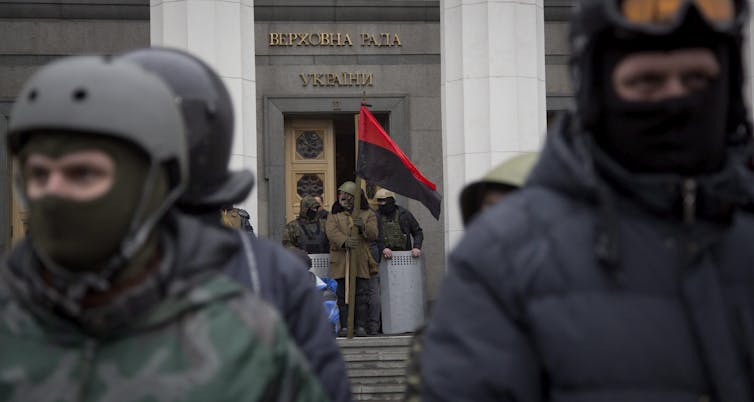 Protesters stand guard in front of the parliament building in central Kyiv, Ukraine, in February 2014 as the country’s embattled president Viktor Yanukovych complained of an ongoing coup. He later fled Ukraine for Russia. (AP Photo/Darko Bandic)
Protesters stand guard in front of the parliament building in central Kyiv, Ukraine, in February 2014 as the country’s embattled president Viktor Yanukovych complained of an ongoing coup. He later fled Ukraine for Russia. (AP Photo/Darko Bandic)
In response, regions in eastern Ukraine — where pro-Russian sentiment is the strongest — saw separatists seize control with scant Russian assistance. These separatists were soon fighting against Ukrainian forces as Russian support began to increase.
According to the Russian government’s Investigative Committee of the Russian Federation, more than 2,600 civilians died and at least 5,500 were wounded in fighting in the separatist regions of Ukraine as of February 2022. Many of them were killed or wounded by Ukrainian forces seeking to crush the separatists.
These figures are supported by data from the West. In January 2022, the United Nations recorded 3,106 conflict-related civilian deaths and as many as 7,000 wounded in fighting in Ukraine up to that point. During that period, most of the fighting was over separatist-controlled territory.
Growing threats to civilians
As Ukraine is increasingly provided with long-range weapons by the West, the potential for civilian casualties as a result of Ukrainian missile and long-range artillery attacks has increased.
While many of these weapons have good accuracy, they nonetheless are too often fired by both sides on the basis of inaccurate or flawed intelligence.
Even after the fighting has moved on from a particular area, the war leaves behind a legacy of unexploded munitions. These can range from unexploded bombs and artillery shells to mines.
In October 2022, for example, the government of the Donetsk People’s Republic reported that combat engineers had destroyed more than 20,000 “Lepestok” or “butterfly” mines on its territory. Western sources have suggested that both Ukraine and Russia have been using anti-personnel mines.
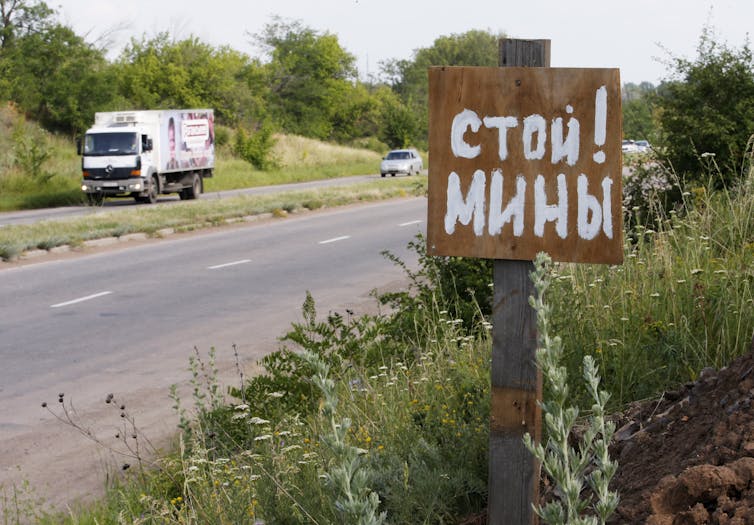
A poster reading ‘Stop! Mines!’ stands near the city of Kramatorsk in the Donetsk region of eastern Ukraine in June 2014. (AP Photo/Dmitry Lovetsky)
Cluster munitions are another particular threat to civilians long after the fighting has moved on from a given area. There have been reports of both the Russians and Ukrainians using cluster bombs to date. Neither Russia nor Ukraine is a signatory to the Convention on Cluster Munitions banning their use.
Cluster bomb use likely to increase
The United States — also not a signatory to the convention — has recently decided to provide Ukraine with cluster munitions from its own stocks. That decision can only increase their use by both Ukraine and Russia, meaning that civilians on both sides of the front line will inevitably fall victim to unexploded munitions over time.
The United States claims the munitions it plans to provide Ukraine will leave behind no more than three per cent of the munitions unexploded. Even if this is accurate — which is unlikely — the immediate effect of this decision “will be to knock away much of the moral ground Washington sits on in this war,” according to one BBC report. The longer-term impact will be more civilian deaths and maiming.
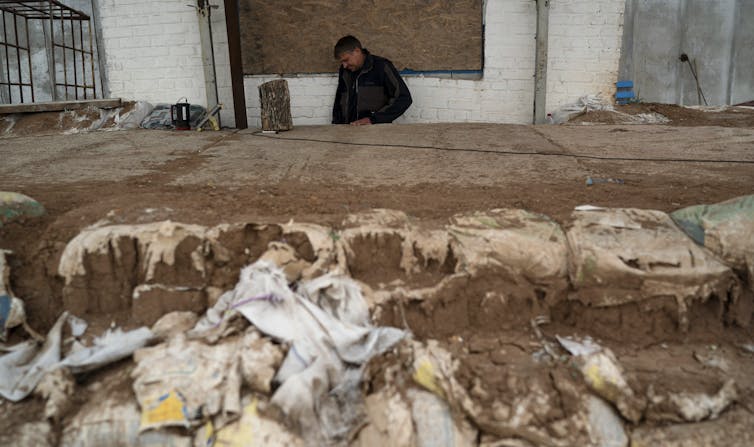
A man enters a shelter near Novomykolaivka, eastern Ukraine. Work on large farms in the area had halted because the fields and buildings have been hit so many times by mortars, rockets, missiles and cluster bombs that farmers are unable to sow the crater-scarred land or harvest any crops. (AP Photo/Leo Correa)
Since 2014 in Ukraine, at least 12,000 civilians have been killed and 22,000 wounded. Those figures continue to increase on both sides of the front line.
Claiming the moral high ground in any war isn’t just about justifying a war effort — it’s also about how a war is fought.
Civilian casualties in war are unavoidable but can be mitigated. Both Ukraine and Russia, sadly but inevitably, have plenty of civilian blood on their hands.![]()
Alexander Hill, Professor of Military History, University of Calgary
This article is republished from The Conversation under a Creative Commons license. Read the original article.
Contact us by email at fund4thepanamanews@gmail.com
To fend off hackers, organized trolls and other online vandalism, our website comments feature is switched off. Instead, come to our Facebook page to join in the discussion.
These links are interactive — click on the boxes

